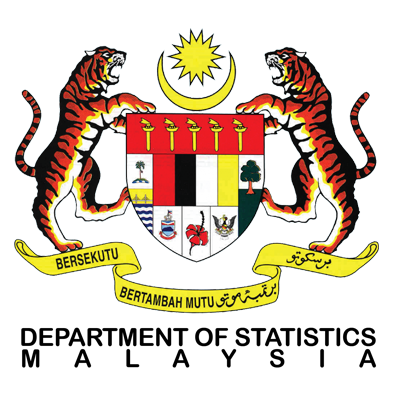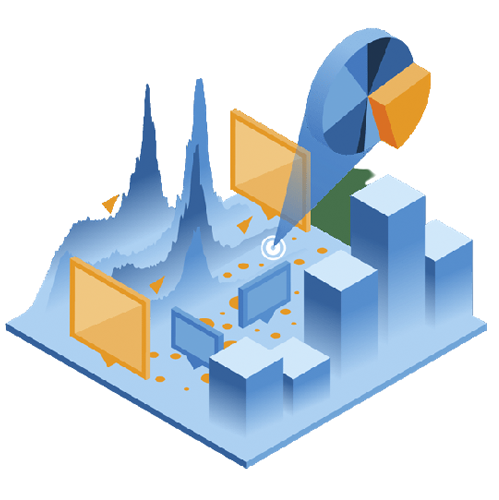Gross Domestic Product by State
- Home
- Statistics
- Economy
- National Accounts
- Gross Domestic Product by State
Gross Domestic Product (GDP) by State, 2024
Overview
MALAYSIA ECONOMIC PERFORMANCE, 2024
Malaysia’s economic landscape in 2024 shows an encouraging outlook, reflected in a GDP value of RM1.65 trillion (2023: RM1.57 trillion) with a growth rate of 5.1 per cent as compared to 3.5 per cent in 2023 (Chart 1). This growth was primarily driven by the Services and Manufacturing sectors, contributing a cumulative 82.5 per cent to the GDP value, registered a growth of 5.3 per cent and 4.2 per cent respectively. The Agriculture sector recorded increases by 3.1 per cent (2023: 0.2%), the Mining & quarrying sector grew marginally by 0.9 per cent (2023: 0.5%) while the Construction sector surged by 17.5 per cent (2023: 6.0%).
Chart 1: Annual percentage change of GDP, Malaysia, 1991-2024
The Services sector, which is the main contributor to the national economy with a share of 59.4 per cent, grew by 5.3 per cent in 2024 as compared to 5.1 per cent in the previous year. This performance was supported by growth in key subsectors such as Wholesale & retail trade, 4.3 per cent (2023: 5.9%), Government services, 4.8 per cent (2023: 4.9%), Real estate & business services, 9.5 per cent (2023: 8.6%) and Transportation & storage, 10.7 per cent (2023: 13.6%). Four (4) states surpassing the national level, namely W.P. Labuan (6.4%), Selangor (6.3%), Johor (6.0%) and W.P. Kuala Lumpur (5.5%).
Exhibit 1: Economic structure by state and kind of economic activity, 2024
The Manufacturing sector, contributing 23.1 per cent to the national economy in 2024, strengthened by 4.2 per cent as compared to a marginal growth of 0.7 per cent in the previous year. This growth was driven by Electrical, electronic and optical products, recovered to 4.1 per cent after contracting 1.6 per cent in 2023. Similarly, Petroleum, chemical, rubber and plastic products showed an increase of 3.2 per cent (2023: -0.8%). Meanwhile, Non-metallic mineral products, basic metals and fabricated metal products strengthened by 7.5 per cent as compared to 5.2 per cent in 2023. Four (4) states that outperformed the national growth were Kedah (6.6%), Perak (5.1%), Selangor (5.1%) and W.P. Kuala Lumpur (4.3%).
The Agriculture sector as a third-largest contributor to the national economy, accounting for 6.3 percentage share of the total, grew by 3.1 per cent. This growth was driven by the Crops subsector (3.6%), Livestock (3.3%) and Fisheries (2.9%). However, the Forestry and logging subsector recorded a decline of 5.4 per cent, with Sabah being the only state to register a positive growth. Oil palm as the largest contributor in the Crops subsector, strengthened by 5.1 per cent as compared to the marginal growth in the previous year. Seven (7) states outperformed the national growth rate, namely Negeri Sembilan (9.8%), Pahang (8.4%), Selangor (6.6%), Johor (4.2%), Kedah (4.0%), Terengganu (3.9%) and Perak (3.6%).
The Mining & quarrying sector continued to record a marginal growth rate of 0.9 per cent (2023: 0.5%), driven by the Natural gas subsector which grew by 3.0 per cent (2023: 0.6%) and the Other mining & quarrying, increased by 3.4 per cent. In contrast, the Crude oil & condensate subsector continued to decline by 2.7 per cent in 2024 (2023: -0.4%), thus slowing the growth of this sector. The geopolitical tensions and the decline in global crude oil prices contributed to a decrease in the country’s crude oil production. As a result, Sabah and Sarawak as a crude oil-producing states, recorded a declines of 7.7 per cent and 2.6 per cent in the production of Crude oil & condensate, respectively.
The Construction sector surged by 17.5 per cent in 2024 as compared to a growth of 6.0 per cent in the previous year. This impressive performance was driven by all subsectors, namely Building construction (16.2%), Specialised construction activities (21.0%) and Civil engineering (16.3%). Among the states that support the strong performance of this sector were Johor (42.7%), Melaka (30.6%), W.P. Kuala Lumpur (21.1%), Kelantan (20.7%) and Sabah (18.8%).
Exhibit 2: Economic growth by state and kind of economic activity, 2024
ECONOMIC PERFORMANCE BY STATES, 2024
Johor recorded the highest growth among other
states for the first time,
at 6.4 per cent (2023: 4.1%), reaching a GDP value of RM158.0 billion as compared to RM148.6 billion in the previous
year (Exhibit 2). This impressive growth was driven by the Services sector, which grew
by 6.0 per cent (2023: 5.4%), supported by increases in the Finance & insurance, real estate and business services, as well as the Utilities, transportation &
storage, and ICT subsectors. The Manufacturing sector also grew by 4.2
per cent (2023: 2.8%), propelled by Wood, furniture, paper and printing products, as well as Non-metallic mineral
products, basic metals and fabricated metal products. The Construction sector grew by 42.7 per cent (2023: 12.7%),
the highest growth among all states, driven by strengthening in all subsectors, with double-digit growth namely Building construction (41.6%), Civil engineering (44.1%) and Specialised construction activities (42.4%). Meanwhile, the Agriculture sector recovered to 4.2 per cent after experiencing a decline of 1.3 per cent in 2023, driven by an increase in Oil palm production.
Kedah’s economy grew by 4.2 per cent (2023: 1.7%) with a GDP value of RM54.0 billion (2023: RM51.9 billion). The economic growth in Kedah was led by the Services sector, which expanded by 3.8 per cent (2023: 4.1%), driven by the Government services subsector and the Wholesale & retail trade, food & beverage and accommodation subsectors. The Manufacturing sector as the second-largest contributor to the state’s economy, grew by 6.6 per cent (2023: -3.2%), supported by Electrical, electronic & optical products as well as Non-metallic mineral products, basic metals and fabricated metal products. Meanwhile, the Agriculture sector recovered to 4.0 per cent, supported by Crops (oil palm and rubber) and Livestock (poultry). However, the Construction sector contracted by 11.1 per cent (2023: 32.8%), due to declines in all subsectors especially in Specialised construction activities.
Kelantan’s GDP value amounted to RM28.7 billion (2023: RM27.7 billion), increased by 3.6 per cent as compared to 2.6 per cent in 2023. The Services sector, which dominates a 71.7 per cent of Kelantan’s economy, grew by 3.4 per cent (2023: 4.0%), fueled by the Government services as well as Wholesale & retail trade, food & beverage and accommodation subsectors. The Agriculture sector as the second-largest contributor to Kelantan’s economy, recovered to 2.8 per cent as compared to a contraction of 1.6 per cent in 2023, supported by strong performances in the Crops and Fisheries subsectors. Meanwhile, the Construction sector surged by 20.7 per cent (2023: 8.3%), propelled by a double-digit growth in the Civil engineering, Building construction and Specialised construction activities subsectors.
Melaka recorded a GDP value of RM48.9 billion (2023: RM46.9 billion), an increase of 4.4 per cent (2023: 2.8%). The Services sector contributing to 51.4 per cent to Melaka’s economy, grew by 4.8 per cent (2023: 4.2%), supported by expansion in the Wholesale & retail trade, food & beverage and accommodation, as well as the Utilities, transportation & storage and ICT subsectors. At the same time, the Manufacturing sector expanded by 3.8 per cent (2023: 0.3%), backed by Petroleum, chemical, rubber & plastic products as well as Electrical, electronic and optical products. The Construction sector surged by 30.6 per cent (2023: 6.5%), stimulated by a double-digit growth across all subsectors, especially in the Civil engineering subsector. Contrarily, the Agriculture sector contracted by 1.0 per cent (2023: 4.0%) due to a decline in the Crops subsector, specifically vegetables.
Negeri Sembilan’s economy reached RM54.3 billion (2023: RM51.9 billion), recording a growth of 4.6 per cent (2023: 1.9%). The Services sector grew by 4.3 per cent (2023: 4.5%), driven by the Utilities, transportation & storage and ICT, as well as Wholesale & retail trade, food & beverage and accommodation and subsectors. The Manufacturing sector increased by 3.9 per cent (2023: 1.2%), stimulated by Electrical, electronic and optical products as well as Non-metallic mineral products, basic metals and fabricated metal products. Meanwhile, the Agriculture sector strengthened by 9.8 per cent (2023: -5.6%), driven by the Crops subsector, particularly Oil palm.
Pahang’s economy recorded a growth of 5.7 per cent (2023: 5.1%), surpassing the national growth of 5.1 per cent, reaching a GDP value of RM68.7 billion (2023: RM65.0 billion). Its economy, led by the Services sector, grew by 4.9 per cent (2023: 6.1%), driven by tourism-related industries, namely Wholesale & retail trade, food & beverage and accommodation as well as Other services subsectors. Meanwhile, the Manufacturing sector experienced a growth of 3.5 per cent (2023: 2.1%), supported by Petroleum, chemical, rubber & plastic products as well as Vegetable & animal oils & fats and food processing products. At the same time, the Agriculture sector strengthened by 8.4 per cent (2023: 1.3%), supported by impressive growth in the Crops subsector, especially Oil palm. The Construction sector also strengthened by 12.9 per cent (2023: 42.3%), supported by growth in all subsectors, namely Civil engineering, Building construction and Specialised construction activities.
Penang’s economic performance posted an increase of 4.8 per cent (2023: 3.2%), reaching a GDP value of RM121.5 billion (2023: RM116.0 billion). The Services sector contributing 48.1 per cent to the state’s economy, moderated by 5.0 per cent (2023: 6.0%), driven by the Wholesale & retail trade, food & beverage and accommodation and as well as Utilities, transportation & storage and ICT. The Manufacturing sector as the second-largest contributor to the state’s economy, recovered by 4.0 per cent (2023: -0.5%), propelled by Electrical, electronic & optical products, in line with the positive increases in global demand for E&E products. Meanwhile, the Construction sector grew by 14.4 per cent, owing to a double-digit growth in all subsectors, especially in the Building construction subsector.
Perak’s economy grew by
4.4 per cent (2023: 2.7%) with
a GDP value reaching RM86.2 billion (2023: RM82.6 billion). This growth was
driven by the Services sector, which expanded by 4.1 per cent (2023: 3.1%), stimulated by the Wholesale & retail trade, food & beverage and accommodation subsectors as well as Utilities, transportation & storage and ICT. The Manufacturing sector also increased by 5.1 per cent (2023: 2.2%), fueled by growth in
Petroleum, chemical, rubber & plastic products as well as Electrical, electronic & optical products. The Agriculture sector which contributing 14.0 per cent to the
state’s economy, grew by 3.6 per cent supported by the Fisheries and Livestock
subsectors. Meanwhile, the Construction sector surged by 11.5 per cent (2023: -2.5%), particularly in Building construction and Specialised construction activities subsectors.
Perlis’s GDP expanded by 3.3 per cent (2023: 2.0%) with an economic value of RM6.5 billion (2023: RM6.3 billion). The Services sector leads the state’s economy rose by 3.3 per cent (2023: 2.4%), driven by the Government services subsector as well as the Wholesale & retail trade, food & beverage and accommodation subsectors. The Agriculture sector as the second-largest contributor to the state’s economy increased by 2.9 per cent (2023: 3.1%), supported by the Fisheries subsector, grew by 10.5 per cent, while the Crops subsector declined by 3.1 per cent, slowing the growth of this sector. At the same time, the Construction sector strengthened by 16.9 per cent (2023: 1.4%), contributed by a significant growth in the Civil engineering subsector.
Selangor, the main contributor to the national economy, grew by 6.3 per cent (2023: 5.4%) with a GDP value of RM432.1 billion (2023: RM406.6 billion). The state’s economy driven by the Services sector posted an increase of 6.3 per cent (2023: 6.1%), boosted by the Utilities, transportation & storage and ICT, as well as the Wholesale & retail trade, food & beverage and accommodation subsectors. Meanwhile, the Manufacturing sector which contributes 29.1 per cent to Selangor’s economy, grew by 5.1 per cent (2023: 2.0%) driven by a surge in Electrical, electronic & optical products as well as Non-metallic mineral products, basic metals and fabricated metal products. The Construction sector also grew positively, recording a growth of 13.2 per cent (2023: 9.5%), stimulated by the Building construction and Specialised construction activities. Likewise, the Agriculture sector recovered to 6.6 per cent (2023: -7.2%), supported by the Fisheries, Crops and Livestock subsectors.
Terengganu’s GDP reached RM39.9 billion (2023: RM38.2 billion) recording an increase of 4.5 per cent (2023: 2.2%). The Services sector, which drives the state’s economy grew by 4.0 per cent (2023: 3.1%) supported by the Utilities, transportation & storage and ICT and Government services subsectors. Meanwhile, the Manufacturing sector as the second-largest contributor to the economy, expanded by 3.9 per cent (2023: 0.2%), supported by Petroleum, chemical, rubber & plastic products. The Construction sector in Terengganu surged by 17.5 per cent (2023: 1.7%), driven by all subsectors, especially in the Building construction. Meanwhile, the Agriculture sector moderated to 3.9 per cent (2023: 6.5%), owing to increases in the Crops and Livestock subsectors. However, the Fisheries and Forestry & logging subsectors declined, thus slowing the growth of this sector.
Sabah’s GDP amounted to RM84.3 billion (2023: RM83.4 billion), growing by 1.1 per cent as compared to 1.4 per cent in the previous year. The Services sector as the main contributor to the state’s economy grew by 4.2 per cent (2023: 4.5%), driven by tourism-related subsectors such as Wholesale & retail trade, food & beverage and accommodation as well as Government services subsectors. The Mining & quarrying sector as the second-largest contributor to Sabah’s economy, continued to decline by 5.0 per cent (2023: -4.5%) due to a drop in the Crude oil & condensate subsector. The Agriculture sector also contracted by 3.4 per cent (2023: 0.6%), influenced by decreases in the Crops (oil palm) and the Fisheries subsectors. The Manufacturing sector edge up to 1.2 per cent (2023: 4.4%), supported by Non-metallic mineral products, basic metals and fabricated metal products. However, the main contributor to this sector, namely Vegetable & animal oils & fats and food processing products (contributing 64.8%) increased marginally by 0.1 per cent, thus slowing the overall growth of the sector. In contrast, the Construction sector in Sabah rebounded to 18.8 per cent (2023: -1.1%), driven by an increase in all subsectors.
Sarawak’s economy grew by 3.9 per cent (2023: 1.3%), reaching RM148.2 billion as compared to RM142.7 billion in 2023. The Services sector increased by 4.9 per cent (2023: 5.2%), driven by the Utilities, transportation & storage, and ICT as well as the Wholesale & retail trade, food & beverage and accommodation subsectors. The Manufacturing sector recovered to 1.3 per cent (2023: -3.9%), supported by Petroleum, chemical, rubber and plastic products. The Mining & quarrying sector rebounded to 4.1 per cent as compared to a marginal decline of 0.1 per cent in the previous year supported by growth in the Natural gas subsector. The Agriculture sector grew marginally by 0.5 per cent, largely supported by Crops subsector, which contributed 82.9 per cent to the sector and rose by 1.4 per cent. Meanwhile, the Construction sector surged by 18.7 per cent supported by the Civil engineering and Specialised construction activities subsectors.
W.P. Kuala Lumpur remains the second-highest contributor to the national economy with a GDP value of RM265.8 billion (2023: RM250.3 billion), strengthening by 6.2 per cent (2023: 3.8%). The Services sector which dominates its economy, grew by 5.5 per cent (2023: 5.0%), outperforming the national growth. This increase was supported by the Wholesale & retail trade, food & beverage and accommodation, as well as the Finance and insurance, real estate & business services subsectors. Meanwhile, the Construction and Manufacturing sectors increased by 21.1 per cent and 4.3 per cent respectively.
The economy of W.P. Labuan recorded a GDP value of RM8.6 billion (2023: RM8.1 billion) strengthening by 5.4 per cent (2023: 1.8%) surpassing the national growth. The Services sector which leads its economy grew by 6.4 per cent (2023: 2.0%) underpinned by Finance and insurance, real estate & business services subsector, particularly in Finance and insurance activities. Meanwhile, the Construction sector grew by 5.3 per cent (2023: 0.1%) driven by positive growth in all subsectors, specifically in Specialised construction activities subsectors. Conversely, the Manufacturing sector shrank by 0.7 per cent influenced by a decline in Petroleum, chemical, rubber & plastic products.
PER CAPITA BY STATES, 2024
Table 1: GDP per capita (RM) by states, 2024
Five (5) states recorded a GDP per capita value exceeding the national level (RM56,734), namely W.P. Kuala Lumpur (RM136,365), W.P. Labuan (RM87,003), Pulau Pinang (RM76,033), Sarawak (RM73,426) and Selangor (RM65,907) as shown in Table 1.
Press Statement
Subscribe
Newsletter
Subscribe to our newsletter and stay updated
For interviews, press statement and clarification to the media, contact:
Baharudin Mohamad
Public Relation Officer
Email: baharudin[at]dosm.gov.my
Phone: 03 8090 4681
Not found what you looking for? Request data from us, through
Go to eStatistik
Email: data[at]dosm.gov.my
Phone: 03 8885 7128 (data request)










